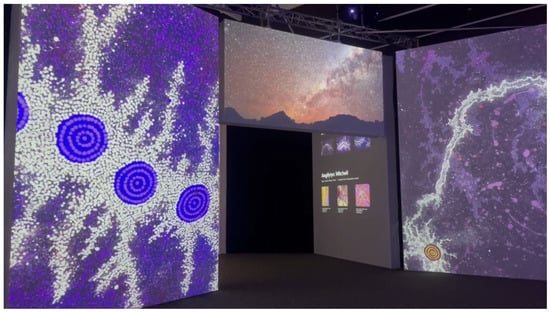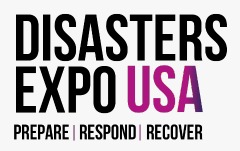Connection: Digitally Representing Australian Aboriginal Art through the Immersive Virtual Museum Exhibition

4.1. Grande Experiences’ Related Works
Connection: Songlines from Australia’s First Peoples represents the 250th immersive experience brought to life by Grande Experiences. As the owners and operators of THE LUME Melbourne and a renowned touring company behind successful exhibitions such as Van Gogh Alive, Monet and Friends, and Da Vinci Alive, the Grande Experiences company has been captivating audiences worldwide since its establishment in 2006. With a remarkable track record, they have provided unforgettable experiences to over 23 million visitors across the globe. In 2020, the company underwent a name change, transitioning from Grande Exhibitions to Grande Experiences. This new name reflects their evolving focus, which extends beyond enhancing the presentation of art, culture, and science, to fully integrating innovative narratives, digital technology, interactive elements, and immersive sensory experiences. This change also underscores the company’s renewed guiding principles, which prioritize audience-centric on-site experiences while bridging the realms of art and entertainment.
Indeed, visitors’ preferences vary when it comes to exploring exhibits from diverse cultural backgrounds. Some individuals enjoy spending extended periods of time delving into specific exhibits, while others prefer a more concise tour, sampling a little bit of everything. It is crucial to consider how to encourage active participation in immersive exhibitions and how to engage visitors on a deeper level than ever experienced before within physical spaces. The philosophy guiding the design of immersive exhibits revolves around understanding visitors’ needs and expectations. It is also essential to recognize the evolution of visitors’ expectations, transitioning from a static viewing experience to immersive interactions within the context of a museum.
The Grande Experiences company’s projects explore the conceptual intersections of art, nature, technology, and human experiences. They offer a prototype that utilizes immersive technologies to push the boundaries of artistic presentations. In turn, this prototype showcases the potential of integrating technology with digitized art, expanding the possibilities for immersive and innovative displays. The Grande Experiences company’s projects not only showcase the close connection between artworks and humans but also demonstrate that reciprocal sensory interactions can be achieved without relying solely on immersive technologies. Through unique curatorial designs, the Grande Experiences company explores ways to create immersive experiences where visitors can engage with artworks and their surroundings, fostering a deeper connection and interaction that goes beyond the digital realm. Generally, the Grande Experiences company pioneers a new frontier in virtual museum exhibitions, pushing the boundaries of immersive and multisensory experiences to unprecedented levels. From the logical and conceptual aspects of the creation process to the exhibition of its final form, the Grande Experiences company introduces innovative strategies and models that have served as inspiration for key arguments presented in this study. The groundbreaking work of Grande Experiences redefines the possibilities of art, opening up new spaces for exploration and challenging traditional notions of artistic expression.
4.2. Connections between Grande Experiences and the Immersive Exhibition of Australian Aboriginal Art
Grande Experiences is one of a few Australian companies specializing in immersive exhibitions, with a proven track record of producing immersive experiences in collaboration with various cultural institutions around the world, including the National Museum of Australia, Kensington Gardens in UK, and Dewey Centre in China.
4.2.1. Contributions of Grande Experiences
Grande Experiences’ selection was attributed to their extensive expertise and experience in creating immersive exhibitions of Australian Aboriginal art. Their prior projects and partnerships have showcased their capacity to handle intricate and culturally sensitive materials, establishing them as a reliable partner. Additionally, Grande Experiences’ advanced technological capabilities and innovative solutions align well with the National Museum of Australia’s vision. Their proficiency in immersive technologies allowed them to provide visitors with a cutting-edge and immersive experience. Furthermore, Grande Experiences have demonstrated a collaborative and consultative approach in their work with Aboriginal communities, artists, and cultural experts in Connection: Songlines from Australia’s First Peoples. This approach ensured the direct involvement of Aboriginal communities in the creation process, helping to prevent any misinterpretation of cultural materials.
4.2.2. Risks Aversion
While Grande Experiences has a commendable track record, the selection of any company to produce immersive exhibitions of Aboriginal art should be based on a combination of factors, including expertise, technological capabilities, collaborative approaches, and a commitment to cultural sensitivity. It is of paramount importance to consider the potential impact and implications of these exhibitions and engage in ongoing dialogues and critical discussions to ensure the respectful representation of Aboriginal cultures. Critical reviews and feedback from Aboriginal communities and cultural experts play a significant role in this process.
Our team at Inergency is excited to announce our partnership with @Disasters Expo Europe, the leading event in disaster management.
Join us on the 15th &16th of May at the Messe Frankfurt to explore the latest solutions shaping disaster preparation, response and recovery.
To all our members, followers, and subscribers in the industry, This is YOUR opportunity to explore the intersection of sustainability and disaster management, connect with industry leaders, and stay at the forefront of emergency preparedness.
Don't miss out! Secure your complimentary tickets now and be part of the conversation driving innovation in disaster resilience. ➡️ https://lnkd.in/dNuzyQEh
And in case you missed it, here is our ultimate road trip playlist is the perfect mix of podcasts, and hidden gems that will keep you energized for the entire journey


